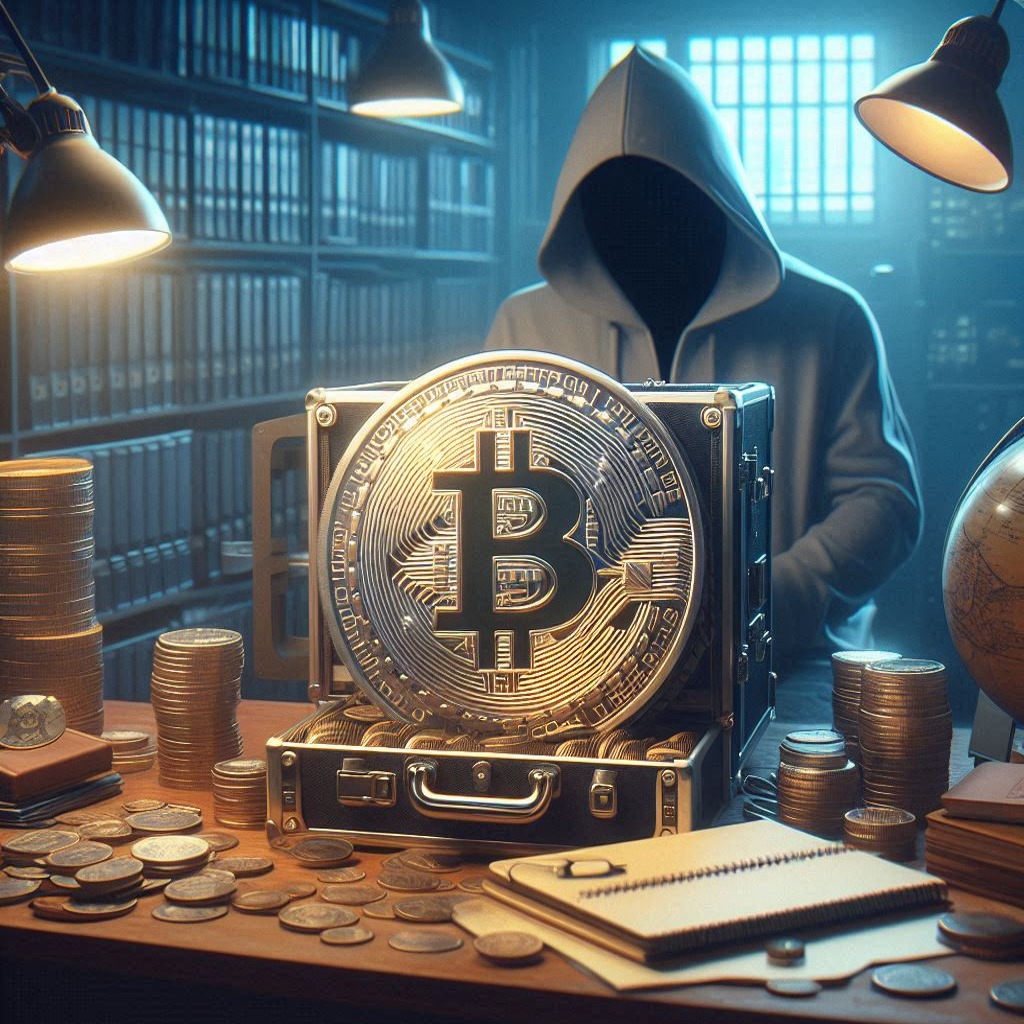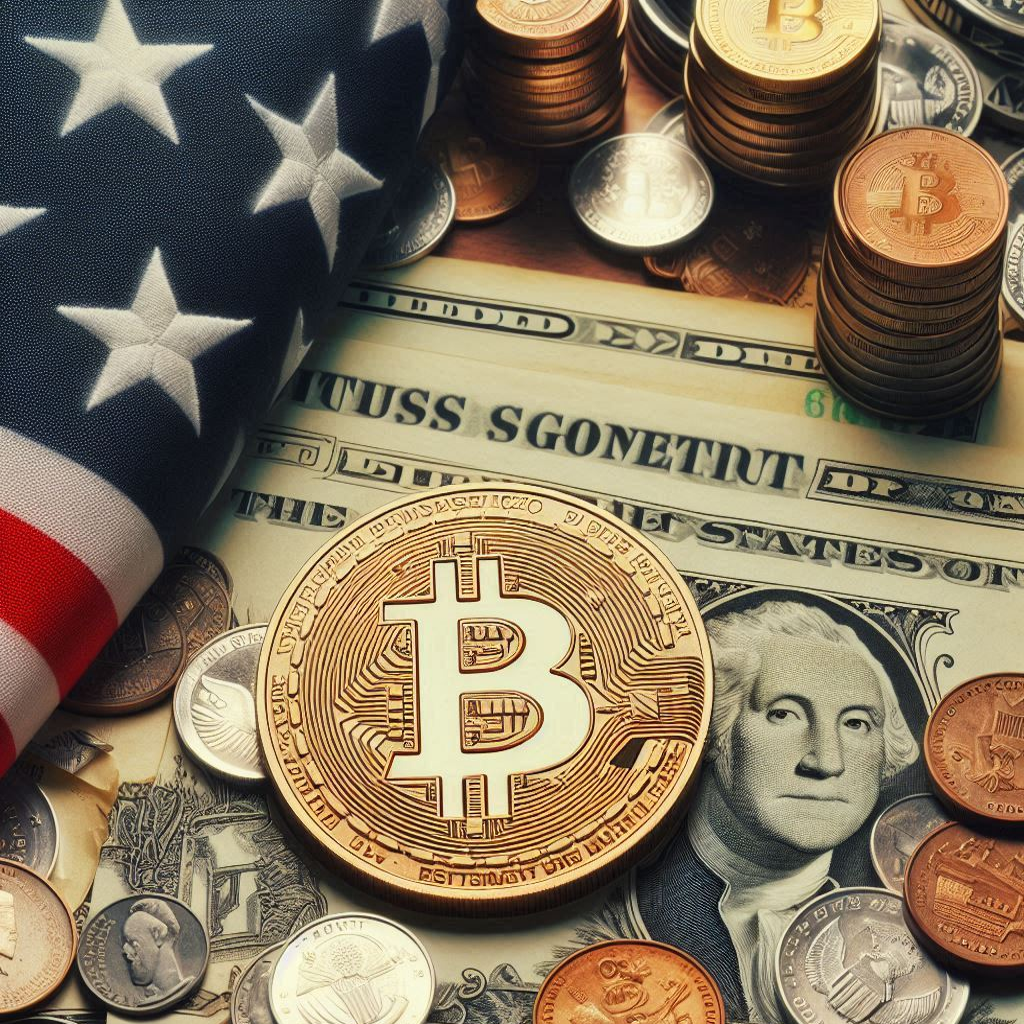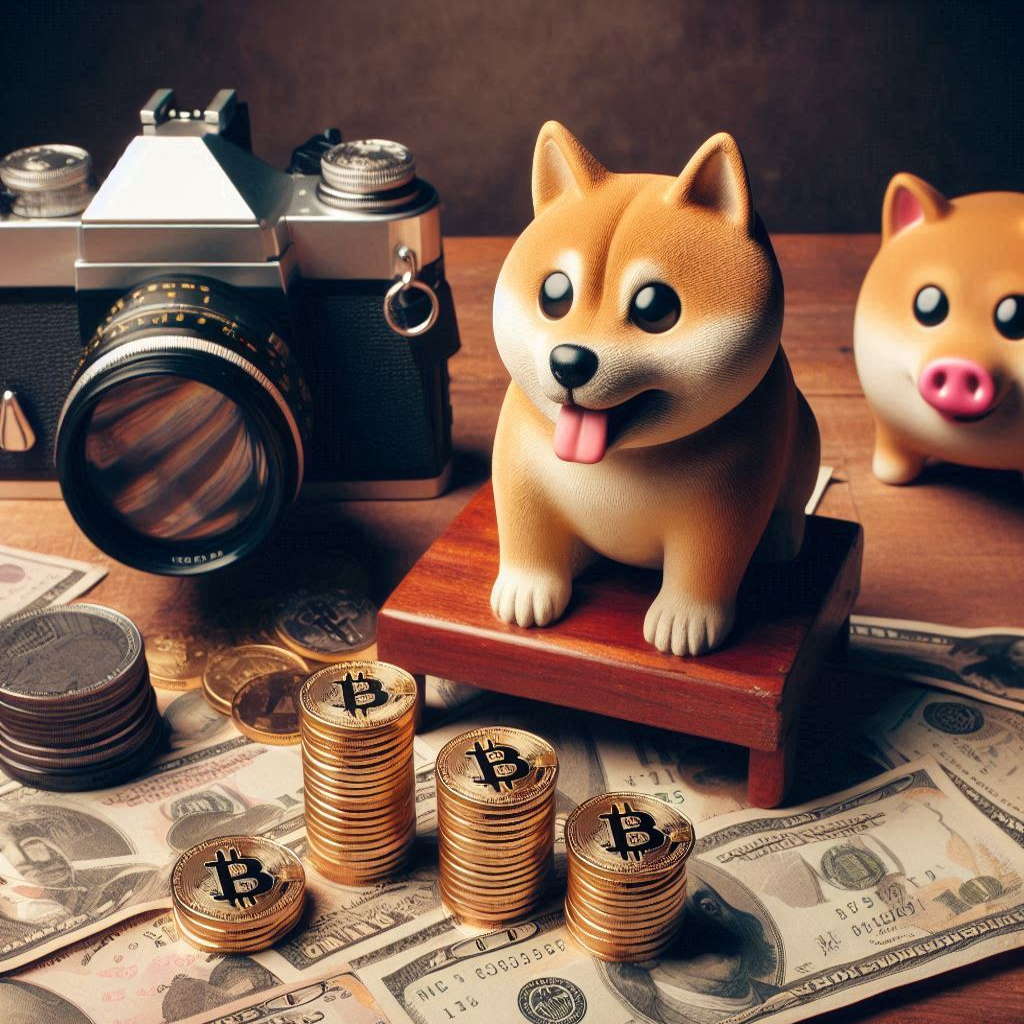
How Much Will Bitcoin Rise in 2025?
Bitcoin is a type of digital money that people use online. It’s special because it is not controlled by any one person or government. Instead, it uses a technology called blockchain to make sure everything is safe and secure. Many people are curious about how much its price will go up in the future, especially in the year 2025.
There are a few reasons people think the price of Bitcoin might rise. First, more and more people are starting to use it. If lots of people want to buy Bitcoin, the price might go up high. Second, some companies are now accepting Bitcoin as payment, making it more popular. Third, there is a limited amount of Bitcoin available, just like rare collectibles. If everyone wants some but there isn’t enough to go around, the price could rise a lot.
However, predicting the price of Bitcoin is very tricky. Sometimes it can go up quickly, and other times it can go down just as fast. It’s also affected by news and events around the world. For example, when the news is good, more people buy Bitcoin, but if the news is bad, people might sell it.
In conclusion, nobody can say for sure how much Bitcoin will rise in 2025. It could go up a lot, or it might not change much at all. It’s always smart to be careful when dealing with money and investments.
Glossary:
1. Bitcoin – a digital currency used online.
2. Blockchain – a safe technology used to track Bitcoin transactions.
3. Price – how much money something costs.
4. Collectibles – rare items that people like to buy and sell.
Understanding Bitcoin and Its Price Dynamics
Bitcoin is the world’s first decentralized digital currency, created in 2009 by an anonymous person or group of people using the name Satoshi Nakamoto. It operates on a technology called blockchain, which is a distributed ledger that records all transactions made with Bitcoin. The price of Bitcoin is highly volatile and is influenced by various factors, making it challenging to predict how much Bitcoin will rise by 2025.
The Factors Influencing Bitcoin’s Price
Several key elements can impact Bitcoin’s price, including:
- Market Demand: The more people want to buy Bitcoin, the higher the price tends to go. This is basic supply and demand economics.
- Government Regulation: Changes in government policies regarding cryptocurrencies can either boost or hinder their prices.
- Technological Developments: Innovations in blockchain technology can lead to increased efficiency and usability, attracting more users.
- Public Perception: Media coverage and public sentiment can dramatically affect how people view Bitcoin. Positive news can lead to price rallies, while negative news can cause drops.
- Competition: The emergence of other cryptocurrencies can affect Bitcoin’s market dominance and price.
Analysts’ Predictions for 2025
Predictions regarding Bitcoin’s future price vary widely among analysts. Some are optimistic, while others are more cautious. Here are a few perspectives:
“Bitcoin is likely to continue its bullish trend as more institutions adopt it as a legitimate form of investment.” – A financial analyst
On the other hand, some experts believe:
“The cryptocurrency market is highly unpredictable, and there’s a significant risk involved in investing in Bitcoin.” – A cryptocurrency expert
Possible Scenarios for Bitcoin in 2025
These scenarios represent different outcomes for Bitcoin’s price based on a variety of influencing factors:
| Optimistic | 100,000 – 500,000 | Widespread adoption, strong market demand, positive regulation |
| Pessimistic | 5,000 – 15,000 | Severe regulation, loss of public interest, market crashes |
| Neutral | 30,000 – 70,000 | Stable growth, moderate adoption, consistent regulation |
Investment Strategies for Bitcoin
If you’re considering investing in Bitcoin in hopes of capitalizing on its potential rise by 2025, consider these strategies:
- Dollar-Cost Averaging: Invest a fixed amount of money at regular intervals, regardless of the price. This helps mitigate the effects of volatility.
- Research and Monitor: Stay informed about market trends, regulatory changes, and technological advancements related to Bitcoin.
- Diversification: Don’t put all your eggs in one basket. Consider diversifying your investments across different cryptocurrencies or assets.
- Long-Term Holding: Some investors adopt a ‘HODL’ strategy, which means holding onto Bitcoin for several years, regardless of short-term price fluctuations.
Final Thoughts on Bitcoin’s Future
Predicting Bitcoin’s price for 2025 is complex and fraught with uncertainties. While some see great potential for significant growth, others warn about the risks involved. Understanding the factors that influence Bitcoin’s price and staying informed will be crucial for anyone thinking of investing.
Q1: How much do experts predict Bitcoin will rise in 2025?
A1: Predictions for Bitcoin’s price in 2025 vary significantly among experts. Some analysts forecast a substantial increase, potentially reaching anywhere from $100,000 to $500,000, while others remain more cautious, estimating a more modest rise. It’s essential to consider that these predictions are speculative and can be influenced by various market factors.
Q2: What factors might influence Bitcoin’s price in 2025?
A2: Several key factors could impact Bitcoin’s price, including regulatory developments, adoption rates by businesses and individuals, technological advancements within the blockchain space, and macroeconomic trends such as inflation and interest rates. The overall market sentiment around cryptocurrencies also plays a crucial role.
Q3: Is investing in Bitcoin for 2025 a wise decision?
A3: Investing in Bitcoin carries inherent risks and rewards. While many investors believe in Bitcoin’s future potential and see it as a hedge against inflation, others consider it highly volatile. It’s essential to conduct thorough research and assess your risk tolerance before making investment decisions.
Q4: How can I stay updated on Bitcoin trends leading up to 2025?
A4: To stay informed about Bitcoin trends, you can follow reputable financial news websites, subscribe to cryptocurrency market analysis newsletters, and join online forums or social media groups dedicated to Bitcoin discussions. Staying engaged with the community can provide valuable insights.
Q5: Should I buy Bitcoin now if I believe it will rise in 2025?
A5: The decision to buy Bitcoin should be based on your financial goals and market analysis. If you believe in its potential rise by 2025, consider investing a portion of your portfolio. However, ensure that you do so responsibly and only invest what you can afford to lose.
Q6: What is the historical performance of Bitcoin leading up to significant price increases?
A6: Historically, Bitcoin has experienced substantial price increases following key events such as halving events, regulatory changes, and significant adoption milestones. Analyzing these patterns can provide insights but remember that past performance is not indicative of future results.

Do You Have to Report Crypto Under $600?
Many people are curious about whether they need to report their cryptocurrency transactions that are under $600. The answer is a bit complicated, so let’s break it down simply.
In most cases, if you make a profit from selling or trading cryptocurrency, you need to report it on your taxes. This is true even if the amount is less than $600. However, there is a special rule called the “de minimis” rule, which allows small transactions under a certain amount not to be reported.
The IRS, which is the agency that collects taxes in the United States, wants to know about all gains, even if they’re tiny. So, if you sell crypto for some money, you need to pay attention. But if you only bought some and didn’t make any money, then there’s nothing to report.
To help understand this better, here are some important terms:
Cryptocurrency: A type of digital money, like Bitcoin or Ethereum, that uses special technology to secure transactions.
Profit: The money you make when you sell something for more than you paid for it.
IRS: The Internal Revenue Service, the U.S. government agency responsible for collecting taxes.
De minimis: A legal term meaning “too minor to bother” which sometimes applies to small transactions.
In short, even if your crypto transactions are under $600, it’s safest to keep records and check with a tax expert. You want to make sure you follow the rules and don’t get in trouble later!
Understanding the Reporting Requirements for Cryptocurrency Under $600
Cryptocurrency has gained immense popularity over the past few years. As more people invest and trade in various cryptocurrencies, a common question arises: do you have to report crypto transactions that are under $600? This topic is important, especially for new investors and casual traders. Let’s explore this issue in detail.
What Does Reporting Mean?
When we talk about reporting in the context of taxes, it means informing the government about your income or earnings. This includes any profits you make from trading or selling cryptocurrency.
What is Cryptocurrency?
Cryptocurrency is a digital or virtual form of currency that uses cryptography for security. Bitcoin and Ethereum are two examples of cryptocurrencies. They can be bought, sold, and traded like stocks.
The $600 Threshold
According to IRS (Internal Revenue Service) guidelines in the United States, you must report your earnings from crypto transactions. However, many people wonder if there’s a specific threshold—like $600—that determines whether or not they need to report these transactions.
“The IRS states that any amount of income, including gains from cryptocurrencies, should be reported to avoid penalties.”
Do You Have to Report Under $600?
- Yes, you should report: Even if your gains are less than $600, you are required to report them. The reason is simple: all income is considered taxable income, regardless of the amount.
- What if you lose money? If you incur a loss from your crypto transactions, you can report that as well, which might help lower your overall tax liability.
What Happens if You Don’t Report?
Failing to report your cryptocurrency earnings can lead to problems with the tax authorities. You may face penalties and additional taxes that can accumulate over time. It’s better to be safe and ensure all aspects of your trading are accurately reported.
Possible Solutions for Reporting
If you are unsure about how to report your crypto transactions, consider these potential solutions:
- Use a Tax Software: There are many tax software programs designed specifically for cryptocurrency transactions. They can help you calculate your earnings and report them correctly.
- Hire a Tax Professional: If you have a lot of transactions or complex dealings, hiring a tax professional may be the best route to ensure you meet all legal requirements.
- Keep Detailed Records: Maintaining records of all your crypto transactions is essential. You should note down the date of purchase, sale, and the amounts involved to make reporting much easier.
Key Takeaways
In summary, reporting your cryptocurrency earnings is crucial, even if they are under $600. Here are some key points to remember:
- All income must be reported, regardless of the amount.
- Losses can also be reported to reduce tax liabilities.
- Using tax software or hiring a professional can help streamline the reporting process.
“It’s essential to be compliant with tax regulations to avoid future issues.”
Final Thoughts
Understanding your tax obligations when dealing with cryptocurrencies is vital for all investors. By staying informed and proactive, you can ensure that you are compliant with IRS guidelines and avoid unnecessary penalties. Remember, it’s always better to report your earnings, no matter how small they may seem.
Do I need to report cryptocurrency transactions under $600?
Currently, the IRS does not require you to report cryptocurrency transactions that result in less than $600 in gains. However, it’s important to keep accurate records of all your transactions for your own reference and in case you exceed the threshold in the future.
What happens if I sell crypto for a gain under $600?
If you sell cryptocurrency for a profit and the total gains are under $600, you are technically not required to report it. However, any gains, regardless of the amount, are subject to taxes. If you find yourself frequently engaging in small transactions, it may be prudent to maintain a record of these transactions.
Are there penalties for not reporting small crypto transactions?
While there are no specific penalties for failing to report transactions under $600, the IRS expects taxpayers to report all income accurately. If you have unreported gains, they could potentially lead to penalties if discovered during an audit.
Should I still keep records of my crypto transactions?
Yes, it’s recommended to keep detailed records of all your cryptocurrency transactions, including those under $600. This way, you have a complete history of your trades and can accurately report any taxable events that may come up in the future.
Is there a difference in reporting rules for crypto and other assets?
Yes, the reporting rules for cryptocurrency may vary compared to traditional assets like stocks or bonds. While small capital gains on stocks also do not need to be reported for amounts under $600, it’s crucial to be aware of the specific rules and regulations that apply to cryptocurrency.
Will regulations change in the future regarding crypto reporting?
Regulations are constantly evolving as governments adapt to the growing cryptocurrency market. It’s wise to stay informed about any changes in tax laws that may affect reporting thresholds or requirements for cryptocurrency transactions.

How Much is $1 Dollar to Bonk?
Have you ever wondered how much $1 is in bonk? It’s a fun question that brings us into the world of currency exchange. Currency exchange is when you change one type of money for another. In this case, we are looking at the value of the dollar compared to bonk, which is a made-up type of money.
The value of $1 in bonk depends on the exchange rate. An exchange rate is like a simple formula that tells us how much one kind of money is worth in another kind. For example, if 1 dollar is equal to 10 bonks, then for each dollar you have, you can get 10 bonks. Easy peasy!
Now, if you are asking how much $1 is to bonk, you would need to know the exchange rate first. If the rate is not clear, we can say 1 dollar could be worth a lot, or just a little, in bonk. Some people might say it’s funny to think about, but it helps us understand how money works!
In short, the answer is all about the exchange rate. So next time you see $1, remember that it can be different amounts if we think of bonk! More fun with money is always a good thing!
Glossary:
Currency exchange: Changing one type of money for another.
Exchange rate: The value of one kind of money compared to another.
Understanding the Value of $1 in Bonk
In the world of cryptocurrencies and digital currencies, understanding how different currencies relate to each other can be challenging. One of the questions that often comes up is, “How much is $1 worth in Bonk?” Let’s explore this topic and break it down.
What is Bonk?
Bonk (often stylized as BONK) is a cryptocurrency that gained popularity in the Solana blockchain ecosystem. It is known for its meme-based nature and community-driven initiatives.
Key Terms Explained
- Cryptocurrency: A digital or virtual currency that uses cryptography for security. It operates on technology called blockchain.
- Blockchain: A decentralized digital ledger that records all transactions across a network of computers. It ensures transparency and security.
- Market Capitalization: The total value of a cryptocurrency, calculated by multiplying its current price by the total number of coins in circulation.
Factors Influencing Value
The value of Bonk in relation to the US dollar can be influenced by several factors:
- Supply and Demand: The more people want to buy Bonk, the higher its price will be, and vice versa.
- Market Sentiment: News and community discussions can affect how people feel about Bonk, leading to price fluctuations.
- Overall Cryptocurrency Market Trends: The performance of the broader cryptocurrency market can impact Bonk’s price. If major currencies like Bitcoin are rising, it might positively affect Bonk too.
Current Exchange Rate
To determine how much $1 is worth in Bonk, we need to look at the current exchange rate. As rates change every moment, you can check various cryptocurrency platforms for the latest value.
| Bonk (BONK) | Current Rate |
“The potential for growth in cryptocurrencies like Bonk is exciting, but it’s essential to understand the risks involved.”
How to Convert $1 to Bonk
To convert $1 to Bonk, you can use a cryptocurrency exchange that lists Bonk. Here’s a simple process:
- Create an account on a cryptocurrency exchange.
- Deposit US dollars into your account.
- Look for the trading pair USDT/BONK or USD/BONK.
- Place an order to buy Bonk with your US dollars.
“Investing in cryptocurrencies can be rewarding, but it’s vital to do your homework and understand what you’re getting into.”
Risk Factors
Investing in cryptocurrencies is not without its risks. Here are some to consider:
- Volatility: Cryptocurrency prices can change rapidly, which means you can lose money quickly.
- Security Risks: There’s a risk of hacking or fraud in cryptocurrency transactions.
- Lack of Regulation: Cryptocurrencies operate in a space that is not heavily regulated, leading to potential scams and market manipulation.
Understanding these factors can help you make informed decisions about whether to invest in Bonk or any other cryptocurrency.
What is bonk?
Bonk refers to a fictional or alternative currency that is sometimes used in games or online communities. Its value can change based on user demand and the context in which it is used.
How much is $1 in bonk?
The conversion rate from dollars to bonk can vary widely depending on the platform or community using bonk. Typically, you would need to check a specific source or marketplace to find the current exchange rate.
Where can I find the current exchange rate for dollars to bonk?
To find the current exchange rate for dollars to bonk, you can look for online forums, gaming communities, or websites that specifically deal with the currency. These platforms often have up-to-date trading information.
Can I trade US dollars for bonk?
Trading US dollars for bonk typically occurs within certain platforms that accept this exchange. It is important to ensure that you are using a reliable platform to avoid scams or inflated rates.
Is bonk a stable currency?
Bonk is usually not considered a stable currency. Its value can fluctuate based on various factors, such as market speculation and community interest. It is advisable to monitor its value closely if you engage in any trading activities.
Are there risks associated with using bonk?
Yes, there are risks associated with using bonk or any alternative currency. These include potential loss of value, lack of regulation, and uncertainty about its acceptance in future transactions.
How can I acquire bonk?
You can acquire bonk through various means, including trading or purchasing from others in the community, participating in online events, or earning it through gameplay in certain applications.
Can I convert bonk back to US dollars?
Converting bonk back to US dollars can be more complicated. Some platforms may allow for this exchange, while others may not. Always check the terms and conditions before attempting any conversion.

How to Check BTC Real or Fake?
Bitcoin (BTC) is a popular type of digital money. Many people want to know if their Bitcoin is real or fake. This is important because fake BTC can lead to losing money. In this article, we will talk about how to tell if your BTC is real.
First, let’s understand some key terms:
Bitcoin: A type of digital currency that works without a bank.
Wallet: A digital place to store your Bitcoin safely.
Transaction: The act of sending or receiving Bitcoin.
Blockchain: A public record that keeps track of all Bitcoin transactions.
To check if your Bitcoin is real, you can follow these simple steps:
1. Look at the Wallet: Make sure you use a safe and trusted wallet. Some wallets are not secure, and they can be tricky.
2. Check the Blockchain: You can use websites that show the Bitcoin blockchain. If your BTC is there, it’s real! Type in your Bitcoin address to see the details.
3. Think About Where You Got It: If you got your Bitcoin from an unknown or shady place, it might be fake. Always buy from reliable sources.
In conclusion, checking if your BTC is real or fake is not too hard. Just follow the steps above and be careful with where you keep your Bitcoin. This way, you can keep your digital money safe and sound!
Understanding Bitcoin
Bitcoin (BTC) is a type of digital currency that allows people to send and receive money over the internet without needing a central authority, like a bank. But with its popularity, the question arises: how to check if Bitcoin is real or fake? This guide will help you understand the signs of real Bitcoin and how to protect yourself.
Real vs. Fake Bitcoin
To determine whether a Bitcoin transaction is real or fake, it’s important to understand how Bitcoin works.
- Blockchain: A decentralized ledger that records all Bitcoin transactions. It’s public and can be accessed by anyone.
- Wallet: A digital program that allows you to store, send, and receive Bitcoin.
- Private Key: A secret number that allows you to access your Bitcoin. If someone else obtains your private key, they can take your Bitcoin.
Signs of Fake Bitcoin
Here are some warning signs that Bitcoin might be fake:
- High Returns on Investment: If someone promises unusually high returns in a short time, it could be a scam.
- Pressure to Invest: If you feel rushed to invest or conduct a transaction, take a step back.
- Unregulated Exchanges: Check if the exchange is regulated by any financial authority.
- Too Good to Be True: If an offer seems too good to be true, it probably is.
“Investing in Bitcoin marketplaces has risks, just like any other investment. Always do thorough research before putting your money into it.” – Expert Financial Advisor
How to Check if Bitcoin is Real
To make sure your Bitcoin is real, you can follow these steps:
1. Use a Trusted Wallet
Always use a reputable wallet when storing Bitcoin. Popular wallets include:
- Coinbase
- Blockchain.com
- Trezor
2. Verify Transactions
You can check Bitcoin transactions on the blockchain. Use a block explorer such as:
- Blockchain.com Explorer
- Blockstream.info
Simply enter your Bitcoin address to see your transaction history.
3. Check for Regulation
Ensure the exchange or platform you are using is regulated by a recognized authority, like a financial regulator in your country.
“The cryptocurrency landscape is filled with both opportunities and risks. Always ensure you’re dealing with reliable platforms.” – Cryptocurrency Expert
Common Security Practices
Maintaining the security of your Bitcoin is crucial:
- Use Two-Factor Authentication: Always enable two-factor authentication on your accounts.
- Keep Your Private Key Secret: Never share your private key with anyone.
- Regularly Monitor Transactions: Keep an eye on your Bitcoin wallet for any unauthorized transactions.
In Case of Suspicion
If you suspect you have fake Bitcoin, follow these steps:
- Immediately stop all transactions.
- Inspect your transaction history on a block explorer.
- Report the incident to the relevant authorities.
In Summary
Checking if Bitcoin is real or fake involves understanding the basics of Bitcoin, recognizing the signs of scams, verifying transactions, and ensuring you use trusted wallets and exchanges. Always stay informed and secure your crypto investments!
What is the best way to check if a Bitcoin is real or fake?
The most reliable way to check if a Bitcoin is real or fake is to verify it on the blockchain. Every legitimate Bitcoin transaction is recorded on this decentralized ledger. You can use a blockchain explorer to look up the specific transaction associated with the address you are examining.
Can I identify a fake Bitcoin by its appearance?
Physical Bitcoins, often made of metal or plastic, can sometimes be counterfeited. However, the appearance of a physical coin does not guarantee its authenticity. The best way to verify a Bitcoin’s authenticity is through its digital transaction history on the blockchain.
What should I look for in a Bitcoin wallet to ensure it’s safe?
To ensure your Bitcoin wallet is safe, look for wallets that offer strong encryption, two-factor authentication, and a good reputation within the cryptocurrency community. Avoid wallets that have been associated with hacks or security breaches.
Are there any signs that can indicate I have received fake Bitcoin?
If you notice discrepancies in transaction details, like unusually high fees or an unknown sender, it could indicate issues. Additionally, if a seller is unwilling to provide a transaction ID for your verification, it’s best to be cautious.
What steps should I take if I suspect I’ve received fake Bitcoin?
If you suspect you’ve received fake Bitcoin, immediately cease all transactions and try to verify the transaction on the blockchain. If you determine the Bitcoin is indeed fake, report it to the platform you used and consider reaching out to relevant authorities.
Can exchanges help me verify if my Bitcoin is real?
Yes, many cryptocurrency exchanges have tools to help you check the authenticity of a Bitcoin. You can often use their platform to track transactions and verify balances. However, make sure you choose a reputable exchange.
Is there a way to avoid fake Bitcoin in the future?
To avoid fake Bitcoin in the future, always buy from reputable sources, do thorough research, and use secure wallets. Stay informed about the latest scams and tricks in the cryptocurrency space.

Is Bitcoin Still a Buy?
Bitcoin is a kind of digital money that people buy and sell over the internet. Since it came out in 2009, many people have wondered if it’s a good idea to buy it. Some think it’s like a new form of gold, while others believe it’s too risky. So, is Bitcoin still a buy? Let’s break it down.
First, we need to understand a few key terms.
Bitcoin: A digital currency that works without banks and is stored on a technology called blockchain.
Blockchain: A digital record where all Bitcoin transactions are kept, making it very secure.
Volatility: This means how much the price of Bitcoin goes up and down. It can change very fast!
Many people see Bitcoin as a way to invest their money and hope to earn more later. However, because of its volatility, the price can change a lot in a short time. For example, in some years, Bitcoin can be very high, and in other years, it can drop quickly.
Some believe that Bitcoin is still a buy because it is being accepted by more shops, and big companies are starting to invest in it. Others worry that it could crash, just like other investments sometimes do.
In summary, whether Bitcoin is still a buy depends on each person’s situation and how much risk they are willing to take. Always do your homework before buying any investment!
Understanding Bitcoin and Its Current Market Position
Bitcoin, created in 2009 by an unknown person (or group) using the name Satoshi Nakamoto, is a digital currency that operates without a central authority or banks. It enables peer-to-peer transactions over the internet. While initially viewed as a novel and risky investment, Bitcoin has evolved into a more mainstream financial asset. But is Bitcoin still a good buy in today’s market? Let’s explore this question in depth.
Current Market Trends
The cryptocurrency market, particularly Bitcoin, has seen significant fluctuations over the past few years. As of now, Bitcoin is often considered a “volatile” asset. This means its price can greatly increase or decrease in short periods. Many investors are wondering whether this volatility presents buying opportunities or risks.
Recent Price Movements
Bitcoin prices peaked in late 2021 but have faced challenges since then. Examining the number of trades and the general market sentiment can provide insights:
- In early 2021, Bitcoin reached an all-time high of about $64,000.
- By mid-2022, prices fell to around $20,000.
- Currently, it is fluctuating between $25,000 and $35,000.
Investment Considerations
When evaluating Bitcoin as a potential investment, consider the following factors:
- Volatility: As mentioned, Bitcoin prices can rapidly change. This leads to both opportunities for profit and risks of loss.
- Long-Term Viability: Some investors believe in Bitcoin’s potential for long-term growth, citing its limited supply (only 21 million Bitcoins will ever exist).
- Market Sentiment: The mood of investors can heavily influence Bitcoin prices. News events, regulatory developments, and technological advancements can all play significant roles.
Potential Risks
Investing in Bitcoin isn’t without its challenges. Here are some associated risks:
- Regulatory Risks: Governments around the world are still figuring out how to regulate cryptocurrencies. Changes in regulation can have sudden and significant impacts on Bitcoin’s value.
- Technological Risks: Issues such as hacking or failure of the blockchain network can undermine confidence in Bitcoin.
- Market Manipulation: The cryptocurrency market is less regulated than traditional markets, leaving it vulnerable to manipulative practices that can distort prices.
Investor Opinions
Different experts have varied opinions on whether Bitcoin is a wise investment at this time. Some view it as digital gold—a store of value, while others see it as a speculative asset. For instance, a well-known financial expert stated:
“Bitcoin has the potential to be the new gold, but the journey will be filled with volatility and uncertainty.”
How to Approach Bitcoin Investment
If you’re considering investing in Bitcoin, here are some strategies to consider:
- Do Your Research: Understand Bitcoin, how it works, and the factors that influence its price.
- Invest What You Can Afford to Lose: Given the volatility, only invest money that you can afford to lose without affecting your financial stability.
- Diversify Your Portfolio: Instead of putting all your money in Bitcoin, consider diversifying across different investments to spread your risk.
- Stay Informed: Follow news regarding regulatory changes, market trends, and technological advancements that could impact Bitcoin.
Final Thoughts
Determining if Bitcoin is still a good buy depends largely on your risk tolerance, investment goals, and market understanding. Some investors continue to see potential in Bitcoin despite its dramatic ups and downs, while others remain wary of its unpredictability. As one analyst pointed out:
“Investing in Bitcoin is not just about buying low and selling high; it’s about understanding the underlying technology and its potential impact on the global economy.”
In the end, whether or not to invest in Bitcoin is a personal decision that should be made carefully, considering both the opportunities and risks involved.
Q: Is Bitcoin still a good investment in 2023?
A: While Bitcoin’s market dynamics can fluctuate, many investors still view it as a long-term investment. It’s important to consider your financial situation and investment goals before deciding.
Q: What factors should I consider before buying Bitcoin?
A: You should evaluate market trends, technological developments, regulatory changes, and macroeconomic conditions. Diversifying your investment portfolio is also essential to mitigate risks.
Q: Are there any risks involved in investing in Bitcoin?
A: Yes, investing in Bitcoin carries risks such as price volatility, regulatory scrutiny, and security concerns related to exchanges and wallets. It’s crucial to conduct thorough research and stay informed.
Q: How do I decide the right time to buy Bitcoin?
A: Timing the market can be challenging. Some investors prefer to use dollar-cost averaging, which involves purchasing a fixed amount of Bitcoin at regular intervals, regardless of the price.
Q: What is the current market sentiment towards Bitcoin?
A: Market sentiment can vary widely, influenced by news, technological advancements, and macroeconomic factors. It’s advisable to monitor market sentiment and analyze various viewpoints.
Q: Can Bitcoin serve as a hedge against inflation?
A: Many investors consider Bitcoin a hedge against inflation due to its limited supply. However, its effectiveness in this role can depend on broader economic conditions.
Q: Should I consult a financial advisor before buying Bitcoin?
A: Consulting with a financial advisor can provide personalized guidance tailored to your financial situation, investment risk tolerance, and long-term goals.
Q: What are some common mistakes to avoid when investing in Bitcoin?
A: Common mistakes include investing without adequate research, overreacting to market volatility, and not securing your investments properly. Always educate yourself and develop a solid investment strategy.
Q: Can Bitcoin be part of a diversified investment portfolio?
A: Yes, Bitcoin can be a part of a diversified portfolio, but it should generally not constitute the majority of your investments. Balancing it with other asset classes can reduce risk.

How High Could Sui Go?
In the world of technology and finance, many people are excited about a new digital currency called Sui. But how high could its value go? This question sparks a lot of interest among investors and tech lovers. Let’s explore what Sui is and some important terms that will help us understand its potential.
Sui is a type of blockchain technology. A blockchain is like a digital ledger that keeps tracks of transactions securely. It allows people to buy, sell, and trade without needing a middleman, like a bank. This is one of the reasons why many think Sui could rise in value.
Now, let’s talk about some key terms:
Blockchain: A system that records information in a way that makes it difficult or impossible to change or hack. It keeps data secure.
Cryptocurrency: A digital or virtual currency that uses cryptography for security. Sui is a type of cryptocurrency.
Market cap: The total value of a cryptocurrency, calculated by multiplying the current price by the total number of coins in circulation. A high market cap usually means a strong investment.
Many people believe that as more people learn about Sui and start using it, its demand will go up. This could make its price rise too. However, the price of any cryptocurrency can be very unpredictable. It’s like riding a roller coaster — it may go up steeply or drop suddenly.
In summary, we can’t know for sure how high Sui could go, but its unique technology and growing interest give it a good chance to rise. Remember, investing can be risky, and it’s always best to do your research before diving in!
The question of how high Sui could go involves understanding various aspects of this emerging blockchain ecosystem. Sui is a layer-1 blockchain that aims to deliver fast transactions, low fees, and easy scalability.
Understanding Sui
Before diving into how high Sui could go, let’s clarify some basic terms:
- Blockchain: A digital ledger system that records transactions across many computers securely and unchangeably.
- Layer-1 Blockchain: The base layer of the blockchain architecture, supporting its native cryptocurrency and smart contracts.
- Scalability: The ability of a blockchain to handle an increasing amount of work or number of transactions effectively.
- Transactions: Actions that transfer value or information between parties on the blockchain.
- Decentralization: The distribution of power away from a central authority to create a more open and transparent system.
The Potential of Sui
Sui has garnered attention for its unique features, including move semantics and parallel execution, allowing the blockchain to handle many transactions simultaneously. This could significantly enhance its throughput.
Factors Influencing the Growth of Sui
- Technological Advancements: As Sui continues to innovate, its ability to offer better performance will attract developers and users.
- Community Adoption: The more users that adopt Sui for their applications, the more robust its network becomes.
- Investment and Funding: Increased investments from venture capitalists can accelerate the development of Sui and its ecosystem.
- Partnerships: Collaborations with other blockchain projects or enterprises can provide additional credibility and exposure.
Challenges Facing Sui
Despite its potential, Sui faces challenges that could impact its growth:
- Competition: The blockchain space is crowded with established players like Ethereum and Solana. Sui must prove its unique value.
- Regulatory Issues: Changes in regulations can affect how Sui operates in different jurisdictions.
- Security Concerns: As seen in other blockchain projects, any vulnerability can lead to loss of user trust and investment.
Real-World Insights
Industry experts have shared their views on Sui’s prospects. According to a prominent blockchain analyst:
“Sui has the potential to capture a significant market share if it successfully implements its technology while building a strong community.”
Another expert noted:
“The scalability solutions offered by Sui could set a benchmark for future blockchain technologies.”
Strategies for Increasing Sui’s Value
For Sui to reach new heights, the following strategies could be considered:
- Enhancing Developer Relations: Encouraging developers to build on Sui by providing better documentation, grants, and tools.
- Improving User Experience: Offering a user-friendly interface and seamless integration with existing platforms.
- Expanding Ecosystem: Building partnerships to create a robust ecosystem of decentralized applications.
Future Outlook
In the rapidly evolving blockchain landscape, it is difficult to predict Sui’s precise trajectory. However, by focusing on innovation, user adoption, and strategic partnerships, Sui has a strong chance to grow significantly.
The question remains: how high could Sui go? This ultimately depends on its ability to navigate challenges and leverage opportunities in the blockchain space.
What is Sui?
Sui is a layer-1 blockchain designed for high throughput, fast transactions, and user-friendly development. It utilizes a unique move programming language that facilitates secure smart contract execution.
What factors influence how high Sui could go?
The potential growth of Sui can be influenced by several factors, including: market demand for decentralized applications, adoption by developers, partnerships, technological advancements, and overall market trends in the cryptocurrency space.
Is there a specific price prediction for Sui?
Price predictions for cryptocurrencies, including Sui, are notoriously speculative and can vary widely. Analysts consider historical data, market conditions, and upcoming developments when making predictions, but no prediction can guarantee future performance.
How does Sui compare to other blockchains?
Sui is often compared to other blockchains based on scalability, security, and usability. It aims to provide low-latency transactions and supports a broader range of decentralized applications, which may give it a competitive edge against established blockchains.
What role does community involvement play in Sui’s growth?
Community involvement is crucial for Sui’s growth. A strong and active community can drive adoption, contribute to development, and promote use cases, which collectively can increase the platform’s visibility and potential market value.
Are there risks associated with investing in Sui?
Yes, like any cryptocurrency investment, investing in Sui carries risks. These can include market volatility, regulatory changes, and the inherent uncertainties associated with new technologies. It is essential for investors to conduct thorough research and consider their risk tolerance.
How can I stay updated on Sui’s progress?
To stay informed about Sui, you can follow official social media channels, subscribe to newsletters, join community forums, and participate in discussions on cryptocurrency platforms to gain insights into updates and developments.

What is the Future of Kusama Crypto?
Kusama is a special type of cryptocurrency that works like a test playground for new ideas. It is a part of the Polkadot network and is known for its speed and flexibility. People use Kusama to try out new features before they go live on Polkadot. The future of Kusama seems bright, and many wonder how it will grow.
One key element of Kusama is its ability to allow developers to build and test their projects faster. This helps them learn what works and what doesn’t. As more projects join Kusama, it can become even more popular.
Kusama has its own version of tokens, called KSM. These tokens can be used for various activities like voting on changes and supporting new projects. The more people believe in Kusama, the more valuable KSM tokens may become in the future.
Overall, the future of Kusama cryptocurrency looks exciting! With more development, more users could join, making Kusama a fun place for trying new ideas.
Glossary:
1. Cryptocurrency: a type of digital money that uses special technology to keep it safe.
2. Polkadot: a network that helps different cryptocurrencies talk to each other.
3. Tokens: digital coins that can be used in a certain system or platform.
4. Developers: people who create software and applications.
Understanding Kusama Crypto
Kusama is a blockchain network that is designed to be a more experimental version of Polkadot. It allows developers to test out new ideas and features before they go live on the Polkadot network. Since it is geared towards experimentation, Kusama is often referred to as a “canary network.” This means that it provides a safe environment to spot any problems before they affect the main network.
The Future of Kusama
The future of Kusama crypto looks promising, with many projects and innovations in the pipeline. As technology evolves and user demands change, Kusama is set to play a crucial role in the decentralized finance (DeFi) landscape.
Key Factors Influencing the Future of Kusama
- Innovation and Development: The Kusama network encourages creative solutions, which leads to faster and more efficient advancements.
- Community Engagement: A strong community can drive the success of a crypto project. The active involvement of users in decision-making is vital for Kusama’s growth.
- Integration with Other Platforms: Collaborations with other blockchain projects can expand Kusama’s reach and capabilities.
- Market Demand: The popularity of decentralized applications (dApps) can significantly influence Kusama’s future as more users look for alternatives to traditional finance.
Challenges Faced by Kusama
- Scalability: As more users join the network, ensuring that it can handle increased demand is crucial.
- Security Risks: The experimental nature of Kusama raises questions about the security of new features and applications.
- Regulatory Issues: Changes in government regulations regarding cryptocurrencies could affect Kusama’s operations and acceptance.
Potential Solutions for a Bright Future
To tackle the challenges mentioned above, several solutions can be implemented:
- Improving Technology: Continuous upgrades to the blockchain technology of Kusama can enhance scalability and security.
- Building Partnerships: Joining forces with well-established platforms can boost credibility and expand user bases.
- Increasing Awareness: Educational campaigns about the benefits of using Kusama can attract more users and developers.
Quotes from Experts
Experts in the field have shared their insights regarding Kusama’s future:
“Kusama serves as an innovative playground for developers looking to launch their projects on Polkadot, revealing the potential for rapid growth.” – Industry Analyst
“The unique approach of Kusama allows for real-time testing of blockchain applications, which is essential for maintaining competitiveness.” – Blockchain Expert
Key Terms to Know
| Kusama | A scalable, multi-chain network for early-stage projects and experimental applications. |
| Polkadot | A blockchain platform that allows different blockchains to interoperate. |
| Canary Network | A test network that provides an early warning mechanism for the main network. |
| Decentralized Finance (DeFi) | A financial system built on blockchain technology that offers financial services without traditional intermediaries. |
What is Kusama?
Kusama is an experimental blockchain network that serves as a proving ground for projects developing on Polkadot. It allows developers to test and deploy their applications in a more flexible environment before moving to the more stable Polkadot network.
What are the key features of Kusama?
Kusama offers a number of features including on-chain governance, scalability, and interoperability. It also has a unique structure that allows for rapid updates and adjustments compared to more established networks.
What is the future potential of Kusama?
The future potential of Kusama is significant as it serves as a testing ground for innovative projects. With its robust infrastructure and active community, it is likely to attract various developers and projects seeking to experiment and iterate quickly.
Is Kusama more risky than Polkadot?
Yes, Kusama is generally considered more risky due to its experimental nature. While it offers great opportunities for innovation, the inherent volatility and potential for rapid changes can lead to greater uncertainty compared to the more established Polkadot network.
How does Kusama support new projects?
Kusama supports new projects through its parachain slots and a unique governance model. Developers can launch their projects, receive feedback, and make necessary adjustments in real-time, fostering a culture of innovation and adaptability.
What is the role of the KSM token in Kusama?
The KSM token is the native cryptocurrency of the Kusama network. It is used for governance, staking, and bonding within the network, allowing holders to participate in decision-making processes and secure the network.
Can Kusama influence the future of cryptocurrencies?
Kusama has the potential to influence the future of cryptocurrencies by fostering innovation and enabling more experimental projects. Its success could inspire other networks to adopt similar models, driving progress in blockchain technology as a whole.
What should investors consider before investing in Kusama?
Investors should consider the high volatility and experimental nature of Kusama. It’s essential to conduct thorough research, understand the associated risks, and keep abreast of developments in the network before investing.
How does the community impact Kusama?
The Kusama community plays a crucial role in its development and governance. Community members contribute to decision-making processes, support projects, and help foster a vibrant ecosystem, which is pivotal for Kusama’s future success.

What is the Invisible App?
The invisible app is a special kind of software that you can use on your phone or computer, but you can’t see it on your screen. It’s like magic! You might not notice it, but it helps your device work better and makes your life easier. For example, it can help with things like sending messages or keeping track of your photos.
Some invisible apps help us with our daily tasks, like reminders for homework or finding the fastest way home. Others can help protect us online by keeping our information safe. Even if you can’t see them, they are really important for making sure everything runs smoothly!
Here are some key terms to know about the invisible app:
Software: A set of instructions that tells a computer or phone what to do.
Device: An electronic tool like a smartphone or tablet.
Online Safety: Ways to protect your personal information when you use the internet.
The invisible app is a great example of how technology works behind the scenes to make our lives funner and easier, even if we don’t always see it! Just like a superhero, it does important jobs without needing a cape!
The concept of the “invisible app” refers to applications that operate in the background without direct user interaction. These apps enhance the user experience while remaining unnoticed. They can perform functions like data collection, automation, and background processing, making them essential for various devices.
Understanding the Invisible App
Invisible apps can be found in numerous contexts. They are often integrated into systems to improve functionality without interrupting the user’s workflow. For example, smart home devices utilize invisible apps to manage tasks such as adjusting the thermostat or turning on lights automatically.
Key Features of Invisible Apps
- Background Processing: These apps run in the background, carrying out tasks without user intervention.
- Data Collection: They can collect data and learn from user behavior to improve future interactions.
- Automation: Many invisible apps automate repetitive tasks, making daily routines more efficient.
The Problem with Invisible Apps
While invisible apps provide many benefits, they can also pose several issues:
- Privacy Concerns: Users may be unaware of the data these apps collect, leading to potential privacy violations.
- Security Risks: If not properly secured, invisible apps can become a target for cyber attacks.
- Dependency: Users might become overly reliant on these applications, reducing their ability to perform tasks manually.
If you’re wondering about the trade-offs, consider:
| Increased Efficiency | Potential Privacy Issues |
| Better User Experience | Security Vulnerabilities |
| Automation of Menial Tasks | Overdependence on Technology |
Possible Solutions to the Challenges
To address the issues surrounding invisible apps, developers and users can take several actions:
- Increased Transparency: Developers should provide clear information on what data is being collected and how it is used.
- Enhanced Security Measures: Implementing strong security protocols can help protect against potential threats.
- User Education: Educating users about the functions and risks of invisible apps can empower them to make informed decisions.
Expert Perspectives
“Invisible apps offer a seamless experience, but we must ensure that users are informed and secure.” – Tech Expert
“As apps become more integrated into our daily lives, understanding their background functions is crucial for user safety.” – Data Privacy Advocate
Recognizing the strengths and weaknesses of invisible apps is essential as technology continues to advance. Balancing efficiency and safety will define the future usage of these applications.
What is the Invisible App?
The Invisible App is a mobile application designed to enhance user privacy by masking and managing various types of personal data. It allows users to control their digital footprint and provides tools for anonymous browsing and secure messaging.
How does the Invisible App work?
The app utilizes advanced encryption techniques to protect user data and ensure secure communication. It can hide certain personal information from apps and websites, making it difficult for third parties to track user activity.
Is the Invisible App free to use?
The Invisible App offers a basic version that is free to download and use. However, there are premium features available through a subscription model that provide additional privacy tools and functionalities.
What platforms is the Invisible App available on?
The Invisible App is available for both iOS and Android devices, allowing a wide range of users to access its privacy features.
Can the Invisible App protect against all types of tracking?
While the Invisible App significantly reduces the ability of trackers to monitor user behavior, it cannot provide complete protection against all forms of tracking. Users should combine its use with other privacy measures for optimal security.
Is my data secure with the Invisible App?
Yes, the Invisible App employs state-of-the-art encryption methods to protect user data. However, users should always review the app’s privacy policy to understand how their data is handled.
How do I get support for the Invisible App?
If you encounter any issues while using the Invisible App, you can access the support section within the app or visit the official website for FAQs and contact information.
Can I use the Invisible App while traveling?
Yes, the Invisible App is designed to work globally, allowing users to maintain their privacy and security regardless of their location. However, users should be aware of local laws regarding encryption and data privacy.

Did Robinhood Have Layoffs?
Robinhood is a popular app that helps people trade stocks and invest money. Recently, there were questions about whether Robinhood had layoffs, which means they might have told some of their workers they no longer had jobs. This can happen when a company needs to save money or is not doing well.
In the past, Robinhood has made decisions to cut jobs because of different reasons, like needing to save money or changing their focus. Layoffs are tough for both the workers who lose their jobs and the company because it can affect how people see the brand. However, sometimes companies have to make these choices to stay strong.
Talking about layoffs can be sad, but they are also a normal part of business. Companies like Robinhood are always trying to find the best way to grow and help their customers. So, it’s important to watch how they move forward and if they will have any changes in the future.
Here are some key terms you may find helpful:
Layoffs: When a company lets go of some employees to save money.
Stocks: Shares of a company that people can buy and sell.
Invest: Putting money into something with the hope of making more money.
Brand: The name or image of a company that people know.
Business: An organization that sells products or services.
In summarry, Robinhood has gone through some layoffs before, and we need to keep an eye on what they do next!
Understanding Robinhood Layoffs
Robinhood, a popular trading app known for its commission-free trades, has faced various challenges since its inception. One of the significant topics that come up in discussions about the company is whether or not it has had layoffs. This article will explore the concept of layoffs, Robinhood’s circumstances, and potential solutions to issues that lead to such decisions.
What Are Layoffs?
Layoffs refer to the termination of employees from their jobs, usually due to economic reasons and not because of employee performance. Companies may lay off employees to cut costs, restructure, or adapt to changing market conditions. Layoffs can be permanent or temporary, depending on the company’s financial situation.
Why Did Robinhood Consider Layoffs?
Robinhood has faced several obstacles, including regulatory challenges and increased competition in the trading market. During tough financial periods, businesses often look for ways to reduce expenses, and layoffs are one of the quickest methods to achieve that.
“In an effort to streamline operations, Robinhood has recalibrated its workforce.”
Historical Context of Robinhood Layoffs
In August 2022, Robinhood announced layoffs impacting approximately 23% of its workforce, which was approximately 780 employees. This decision was part of a broader plan to manage costs and focus on profitability.
“As we look at our business, we’ve made some difficult decisions to reduce our team size.”
Impact of Layoffs on Employees
Layoffs can have a profound impact on the remaining employees and the overall company culture. Key effects include:
- Morale Issues: Layoffs can lead to uncertainty and lower morale among remaining staff.
- Increased Workload: The remaining employees may face a larger workload, leading to stress and burnout.
- Trust Issues: Layoffs can create an environment of distrust in management.
How Can Companies Handle Layoffs More Effectively?
While layoffs may be necessary, companies can take steps to handle them in a more humane and effective manner:
- Transparent Communication: Keeping employees informed about the situation can help avoid misunderstandings.
- Severance Packages: Offering fair severance packages can assist laid-off employees in transitioning to new jobs.
- Support Services: Providing career counseling and job placement services can help affected employees find new opportunities.
The Future of Robinhood
Despite the layoffs, Robinhood has been making efforts to innovate and improve its platform. The company is exploring new features and services to attract and retain users. This is crucial for its long-term survival in a competitive market. As co-founder Vlad Tenev stated:
“We are focused on building a company that will serve millions of customers.”
Conclusion
Robinhood’s layoffs are part of a larger conversation about the challenges facing modern companies. While reductions in workforce can be difficult, understanding the reasons behind them and implementing solutions can help both the company and its employees navigate these tough times.
| 2022 | Layoffs | 23% |
Q: Did Robinhood have layoffs?
A: Yes, Robinhood has experienced layoffs in the past as part of their organizational restructuring and efforts to streamline operations.
Q: When did the layoffs occur?
A: The layoffs have occurred multiple times, with significant reductions announced in 2020 and 2022 as the company adjusted to changes in the market and its business model.
Q: How many employees were affected by the layoffs?
A: The number of affected employees varied with each round of layoffs. For example, in 2022, the company announced it would cut approximately 9% of its workforce.
Q: What were the reasons for the layoffs at Robinhood?
A: The primary reasons for the layoffs included shifts in market conditions, operational efficiencies, and the need to focus on long-term growth strategies in a competitive landscape.
Q: How did Robinhood communicate the layoffs to its employees?
A: Robinhood communicated the layoffs directly to impacted employees through meetings and formal announcements, often aiming to provide support and resources for those affected.
Q: What is Robinhood doing to support laid-off employees?
A: The company typically offers severance packages, extended health benefits, and career transition assistance to help laid-off employees find new opportunities.
Q: Are there any plans for future layoffs?
A: While company forecasts and market conditions are constantly changing, there has been no official announcement regarding future layoffs. However, the company does regularly assess its workforce needs.
Q: How can I stay updated on Robinhood’s employment status?
A: To stay updated on Robinhood’s employment status and any possible layoffs, the best approach is to follow official company announcements and news related to the finance and tech sectors.

What is the Highest Price XRP Reached?
Understanding XRP and Its Price History
XRP is a digital currency created by Ripple Labs, and it was released in 2012. It was designed to facilitate fast and low-cost international money transfers. One of the major points of interest for investors and enthusiasts alike is the price of XRP and its historical peaks.
What is XRP?
XRP serves as a bridge currency in cross-border transactions, allowing different currencies to be exchanged without having to convert to a common currency first. This feature makes it appealing to banks and financial institutions.
Historical Price Peaks of XRP
The highest price XRP ever reached was an astounding $3.84 in January 2018. This period marked the peak of the cryptocurrency boom, where many cryptocurrencies experienced dramatic price increases.
“In early 2018, XRP gained immense traction, and its price soared to an all-time high, signifying the increasing mainstream acceptance of cryptocurrencies.”
Factors Influencing XRP Prices
- Market Sentiment: Positive news about Ripple and partnerships with banks often lead to price spikes.
- Regulatory News: Developments regarding cryptocurrency regulations can significantly affect XRP’s price.
- Technological Developments: Improvements and upgrades to the Ripple network can enhance its utility, driving demand and price.
Current Price Trends
As of now, while XRP has experienced fluctuations, it continues to be a popular choice among investors. Understanding market trends is essential for anyone interested in investing in XRP.
Potential Solutions to Price Volatility
Price volatility is a common issue in cryptocurrency markets. Here are some strategies to navigate this:
- Diversification: Spread investments across various cryptocurrencies to minimize risk.
- Long-term Holding: Many investors choose to hold XRP for a prolonged period, banking on future price increases.
- Research and Analytics: Utilizing market analysis tools can help investors make informed decisions.
Quotes from Experts
“Investors should always be cautious with cryptocurrencies. The market is unpredictable, and understanding the dynamics is crucial for making sound decisions.”
With the information provided, we can better understand what XRP is, its peak price, and factors affecting its price. Following these tips can help individuals navigate the exciting yet volatile world of cryptocurrency investments.
Glossary of Important Terms
| XRP | A digital asset or cryptocurrency designed for fast and low-cost international transactions. |
| Market Sentiment | The overall attitude of investors toward a particular security or market. |
| Diversification | The practice of spreading investments across various assets to reduce risk. |
| Volatility | The degree to which the price of an asset varies over time. |